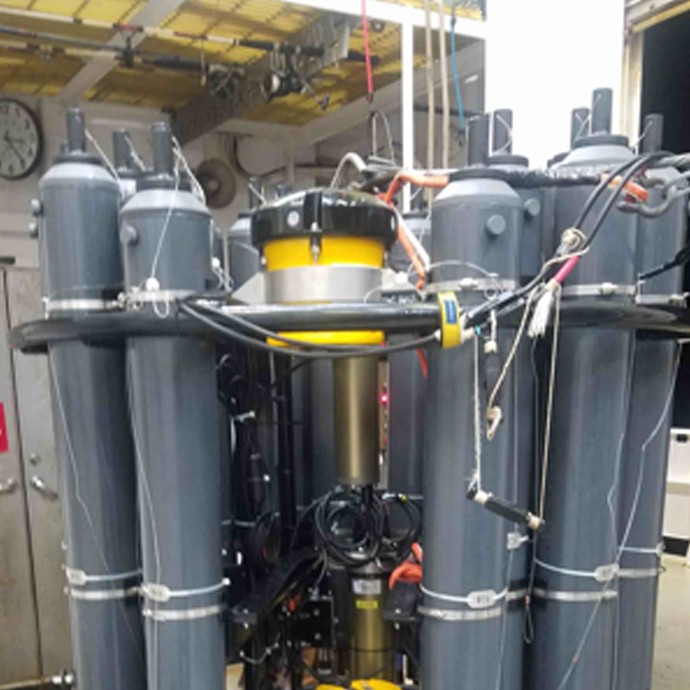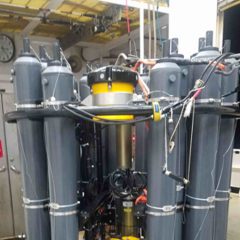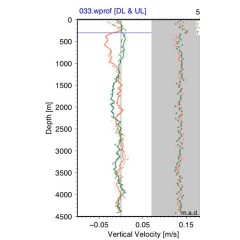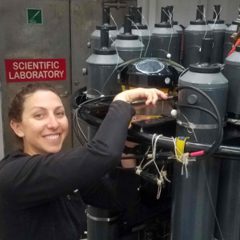Photo Gallery Story
Originally published on the GOSHIP I07 Blog. Author: Amanda Fay
Time is flying! After so many weeks at sea I’m happy to report that spirits are high and everyone is going with the flow. Speaking of flow…let’s learn about currents!
So I am here as the sole person in charge of the LADCP or Lowered Acoustic Doppler Current Profiler, although I get lots of help from Jay and Andy. These instruments are attached to the rosette frame and use the Doppler effect of sound waves to measure the speed of water throughout the water column. ADCPs are very common in oceanographic work and can also be used in an anchored setup on the seafloor as well as mounted on seawalls or bridge pilings. Ships also frequently have ADCPs attached to their hulls, which allows them to take constant current measurements as the boat moves.
In our case, we use LADCPs, which means the instruments are lowered to the ocean floor and then brought back up in order to get a complete profile of the water column. There are 2 LADCP instruments on the platform- one that looks downward (the master) and one that points upward (the slave) as well as a battery pack that provides the instruments with power during their nearly 4 hour ocean voyage (depending on depth of the cast) at each sampling station. When the instruments are on deck between stations, they and the battery are connected to the ship’s power through a train of long black cables.
So what do I do? About 15 minutes before we reach the sampling station, I go into the lab adjacent to the sampling bay and begin the process of getting these instruments up and running in preparation for their next dive into the water. I check their status, erase their current files to make room for new data, and then get them all set to go. They start “ping-ing” and a few minutes later they are in the water.
The ADCP measures water currents with sound using the principles of the Doppler effect. Sound waves have a higher frequency when they move toward
you than when they move away from you. The ADCP works by transmitting “pings” at a constant frequency while in the water. As the sound waves travel, they ricochet off particles in the water such as silt or plankton. The reflected sound is then bounced back to the instrument. The waves reflected off of a particle moving away from the instrument send back a slightly lowered frequency, while reflections off particles moving toward the instrument send back slightly higher frequency waves. The difference between what gets sent out and what the instrument receives is called the Doppler shift. The instrument uses this shift to calculate how fast the particle and the water around it are moving.
When the instruments get back on deck I reconnect power to them and the battery and begin downloading the precious data they hold. Some immediate QC is done to ensure things look good (cables haven’t gone bad, the battery is providing sufficient power, etc). Later, I process the data to see what kinds of currents we are seeing in the water. Sometimes this shows that I need to swap out an instrument (no small feat as they are quite heavy and awkward). Currently we have a Master that is operating with only 3 of its 4 beams operational. This is ok- redundancy is key in these types of instruments and they are able to work with just 3 beams, but no less.
And that’s how we use sound to measure the motion of the ocean.
Image Captions
From Left:
- A full view of instruments attached to the platform. The LADCPs are the yellow instruments and the battery pack is the large cylinder sitting in front of the downlooker LADCP. Photo Credit: NOAA.
- The downcast and upcast are plotted in orange and green respectively. We see a strong surface current at this station on the downcast. Current behavior can provide clues related to seabed bathymetry and much more.Photo Credit: NOAA.
- Here I am in the process of changing out the uplooker in between stations.Photo Credit: NOAA.



